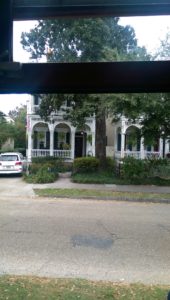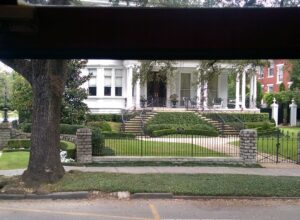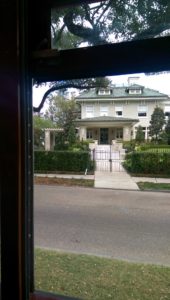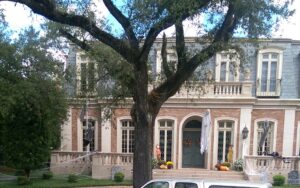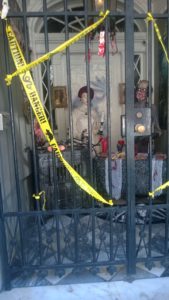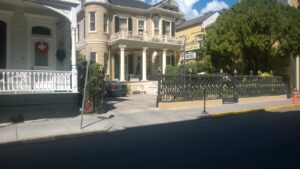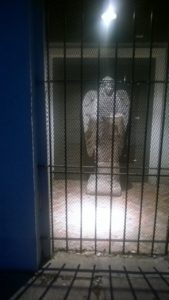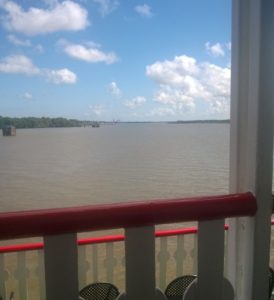
By Sunday morning, the French Quarter returns to its usual lazy self, devoid of most of its tourists (except the ones on the cemetery tour), and we felt more relaxed. We ambled across to the Toulouse St. Wharf, where we would board the steamboat “Natchez” for a brunch jazz cruise. It was a hot day, or at least it felt like a hot day; I missed the cloud cover we’d gotten yesterday and the day before. Still, there was plenty of shade in the waiting area, and shortly we were herded aboard. They have a streamlined operation, checking tickets and bags and then tickets again with a speed that kept the line moving. We settled in to our table with a view of the river–the wrong view, we soon discovered. We were on the “right” side (they don’t mess around with port and starboard for the tourists), which when you’re going downriver is on the wrong side of the boat to see all the things the tour guide talks about. But because we were aboard early, we ate our brunch quickly and found seats outside on the correct side. It was also the shady side. Good times all around.
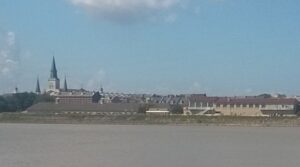
The Mississippi is a big, sprawling river, and we saw quite a few cargo ships going both directions. I don’t remember half of what the tour guide said, I was so preoccupied with watching for what might be coming up next. We went about seven and a half miles downriver, turned around, came back and turned around again, and I never got tired of watching the shoreline. We probably should have switched seats when the steamboat turned around to return, since we were now in the sun, but I wanted to see the other side of the river. So we sat, and sweltered a bit, and marveled at what it must have felt like to those early explorers, coming across the river in their journeys.
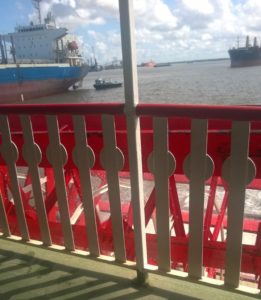
One thing we noticed that we never did remember to ask about was the lack of pleasure vessels on the river. The last time we were in Portland, we drove along the banks of the Columbia and saw fleets of yachts and houseboats, and that river is open to commercial traffic too. It was odd.

We passed the site of the Battle of New Orleans, which has a bitty version of the Washington Monument, only it’s to Andrew Jackson and his troops.
The tour guide also pointed out the Natchez’ “rival,” the Creole Queen. “It’s not a real steamboat,” he said, and proceeded to explain that it’s powered by a diesel engine where the Natchez has actual steam engines. We were glad we hadn’t been taken in by any phony steamboats.
After the cruise, we walked upriver as far as the Riverwalk outlet stores, where we went inside briefly for some cool air, then walked back to our rooms by way of Canal St. Being the geniuses we are, we didn’t think to look for pedometer apps until two days ago, and it’s been amusing to see how they disagree with each other as to distance covered even though we walked the same route. They turn out to be sensitive to whether you’ve got the phone on your person or just tucked into your purse, and despite the unreliability, it’s been fun tracking how far we go.
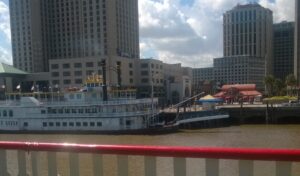
We read for a few hours until it was time to eat dinner, and the Plot Whisperer wanted to go to the first place he’d ever voluntarily eaten seafood. Seafood is a new thing for him, and still not a favorite, so when offered the seafood-free gumbo he leaped on it. I had shrimp etouffee and it was delicious, though now I’m craving red beans and rice.
Tomorrow, we head home. It’s been a real adventure.
